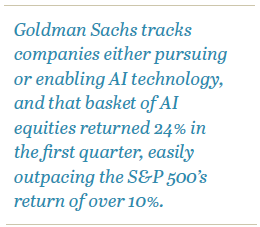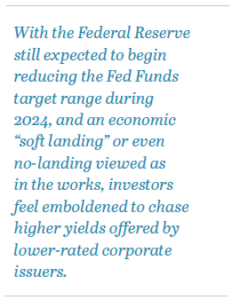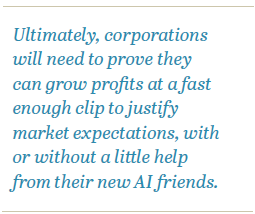Jon Manchester, CFA, CFP® (Senior Vice President, Chief Strategist – Wealth Management, and Portfolio Manager – Sustainable, Responsible and Impact Investing) explores the quarter’s main themes: the hype (and rise in stock prices) of companies pursuing or enabling AI technology; risk-on in the options and credit markets; and an overall look at the economy.
The corporate version of name-dropping was on full display during fourth quarter earnings season. By definition repetitive, this ritual of reporting earnings every three months can seem like a “check-the-box” exercise. A press release is issued, and then select members of the management team host a call with Wall Street analysts to discuss the results. Generally, the prepared statements start with a raft of disclosures, followed by thanking employees for their hard work, and some sweeping comments meant to say that it was a good quarter in the face of various challenges. For those hardened analysts who follow the company on a daily basis, it can be a lot of white noise. There are, however, certain words or phrases that can pierce the solemnity. The buzziest of which today, of course, is to mention artificial intelligence (AI). These two words seem to have a near mystical way of transforming an otherwise staid affair into an event filled with promise.
This has not escaped executives. According to Goldman Sachs, 36% of companies in the Standard & Poor’s 500 Index discussed AI on their Q4 earnings calls, a new high.1 Over 80% of Tech sector companies mentioned AI, not surprisingly, but the prevalence is expanding in other areas. The Energy sector saw the largest increase in the percentage of companies mentioning AI, buoyed by a push to automate processes and analyze vast reams of data. Elsewhere, Bank of New York Mellon Corp said they are using AI to do mundane tasks and noted that AI is saving their research team two hours a day by harvesting data and assembling a rough draft of research communications. Procter & Gamble is using AI tools to optimize truck scheduling, fill rates, routing, and sourcing, which they identified as a combined $200 million to $300 million savings opportunity. Investors and analysts alike can embrace a slimmed down cost structure, which enables more revenues to drop to the bottom line. For some firms AI is a revenue opportunity (see: NVIDIA), while for others it might be a way to run leaner and squeeze more profits out of the same business.
 The stock market continues to reward companies that are AI-hip, seemingly regardless of how early they are on the adoption curve. Goldman Sachs tracks companies either pursuing or enabling AI technology, and that basket of AI equities returned 24% in the first quarter, easily outpacing the S&P 500’s return of over 10%. The transformational nature of AI played a supporting role in the successful Initial Public Offering (IPO) of online platform Reddit during the closing days of March. The stock priced at $34/share initially, before jumping 48% on its first day of trading. This, for a company founded in 2005 that has yet to turn an annual profit, booking a roughly $91 million loss last year. With around one billion cumulative posts across 100,000 active communities on its site, Reddit is hoping it can license its content to companies that train AI models.2 Reuters reported in February that Reddit secured a deal with Google worth $60 million annually, providing a proof point for the bull case.
The stock market continues to reward companies that are AI-hip, seemingly regardless of how early they are on the adoption curve. Goldman Sachs tracks companies either pursuing or enabling AI technology, and that basket of AI equities returned 24% in the first quarter, easily outpacing the S&P 500’s return of over 10%. The transformational nature of AI played a supporting role in the successful Initial Public Offering (IPO) of online platform Reddit during the closing days of March. The stock priced at $34/share initially, before jumping 48% on its first day of trading. This, for a company founded in 2005 that has yet to turn an annual profit, booking a roughly $91 million loss last year. With around one billion cumulative posts across 100,000 active communities on its site, Reddit is hoping it can license its content to companies that train AI models.2 Reuters reported in February that Reddit secured a deal with Google worth $60 million annually, providing a proof point for the bull case.
Yield Or Yield Not

For all of these direct or indirect beneficiaries of AI spend, analysts face an ongoing challenge to estimate both the size and duration of the AI revenue streams. In the meantime, investors aren’t waiting to catch a later train. In fact, some are resorting to unusual measures, Convertible bonds normally offer a positive interest rate in addition to the right to convert the bonds to equity shares at a set price. In March, San Jose, California-based Super Micro Computer rode a more than 1,000% AI-stoked rally over the trailing 12 months into a coveted spot in the S&P 500 Index. A leading provider of high-performance AI servers, Super Micro issued convertible debt in February with a 0% interest rate, and the yield quickly traded into negative territory, finishing the quarter at -2.1%. In other words, investors are paying for the privilege of lending money to Super Micro, the inverse of the typical arrangement. They do, however, have the carrot of potentially converting the bonds to equity shares by February 2029, which could prove worthwhile if the stock price continues to ascend.
Options trading is another area of the capital markets full of pep. In March, options volumes on U.S. single stocks exceeded trading volumes on the underlying equities for the first time since 2021.3 Technology stocks dominated the options leaderboard by absolute volumes, and options on companies involved with AI or cryptocurrencies proved a flytrap for investors buzzing around those themes. Super Micro’s average three-month options volumes equated to an astonishing 22% of the stock’s market capitalization as of mid-March, the highest percentage on that metric for the trailing three-month period, according to Goldman Sachs Derivatives Research. This is all a bit reminiscent of 2021, when meme stocks, options, and cryptocurrencies were running hot. Barron’s recently suggested the options market is in the throes of a speculative mania, due in large part to heavy trading on options that expire in under a week.4 That includes same-day expirations, also known as zero days to expiration (0DTE), and Barron’s sees echoes of the 1920’s bucket shops that enabled people to gamble on stock price changes without owning shares. Speculation is admittedly nothing new in financial markets, always burning at the edges of town, but has a bad habit of causing more widespread damage when the winds are right.
Not to be outdone, the credit markets have likewise adopted a risk-on approach. With the Federal Reserve still expected to begin reducing the Fed Funds target range during 2024, and an economic “soft landing” or even  no-landing viewed as in the works, investors feel emboldened to chase higher yields offered by lower-rated corporate issuers. The Barclays Capital U.S. Corporate High Yield Index spread over the 10-year U.S. Treasury Note yield declined to 346 basis points (bp) at the end of Q1. A year prior, that spread was 502 bps, close to the average of the last three decades. A Bloomberg piece said credit markets are acting like the go-go days of the easy money era are back again.5 Issuers with ratings deep into junk territory are returning to market and meeting strong demand, the article notes. The environment remains favorable, with default rates staying low. JPMorgan’s data puts the trailing 12-month U.S. high yield default rate at just 1.66% versus a 25-year average of 3.00%.6 With almost no room for improvement, reaching for yield down the credit spectrum may not pay off, particularly considering the availability of risk-free rates north of 5% at the short end of the Treasury yield curve.
no-landing viewed as in the works, investors feel emboldened to chase higher yields offered by lower-rated corporate issuers. The Barclays Capital U.S. Corporate High Yield Index spread over the 10-year U.S. Treasury Note yield declined to 346 basis points (bp) at the end of Q1. A year prior, that spread was 502 bps, close to the average of the last three decades. A Bloomberg piece said credit markets are acting like the go-go days of the easy money era are back again.5 Issuers with ratings deep into junk territory are returning to market and meeting strong demand, the article notes. The environment remains favorable, with default rates staying low. JPMorgan’s data puts the trailing 12-month U.S. high yield default rate at just 1.66% versus a 25-year average of 3.00%.6 With almost no room for improvement, reaching for yield down the credit spectrum may not pay off, particularly considering the availability of risk-free rates north of 5% at the short end of the Treasury yield curve.
The Simple Bare Necessities
Personification is a figure of speech, in which objects are given human traits. The next time you dine out with friends, for example, you might say the crème brûlée is calling your name. Although not literally true, it’s fun to imagine the siren call of the dessert menu. If we were to choose one word to describe inflation at present, stubborn seems to be the adjective of choice. After peaking at 9.1% year-over-year growth in June 2022, the Consumer Price Index (CPI) decelerated to just a 3.0% rate a year later. Since then, progress has stalled, leaving CPI up 3.2% year over year in February 2024. The Fed’s favored inflation metric, the Personal Consumption Expenditures (PCE) Core Index, was a little less stubborn, ringing in an increase of 2.8% year over year in February.
This has complicated decision-making for the Fed, and delayed the highly-anticipated pivot to easier monetary policy. Fed chairman Jerome Powell acknowledged the pickle they are in during his March 2024 press conference: “We know that reducing policy restraint too soon or too much could result in a reversal of the progress we have seen on inflation and ultimately require even tighter policy to get inflation back to two percent. At the same time, reducing policy restraint too late or too little could unduly weaken economic activity and employment.”7 Eight months past the last Fed Funds rate hike, economic data has largely remained solid. The unemployment rate has stuck under the 4% mark since January 2022. Gross Domestic Product (GDP) grew 3.1% inflation-adjusted in 2023, and the median Fed projection expects a little over 2% growth this year. Existing home sales jumped 9.5% in February 2024, an encouraging sign amidst elevated mortgage rates.
There are pockets of weakness. The Institute for Supply Management (ISM) monthly manufacturing survey posted a 16th-consecutive contractionary month in February, before finally creeping into expansion territory in March. Similarly, the Conference Board’s Leading Economic Indicators (LEI) Index managed a 0.1% month-over-month increase in February, snapping a nearly two-year journey in negative territory. Still, no recession, and perhaps it doesn’t need to be complicated. Consumers are employed, with added tailwinds from the financial markets, steady housing prices, and well-anchored inflation expectations.
Equity valuations for the largest U.S. companies seem to fully discount the “good enough” economy and the Fed pivot potential. Estimated S&P 500 Index operating earnings for 2024 actually slightly decreased during Q1, dropping from $242 per share at the outset to $240 at quarter end.8 Combined with a 10% price increase, the Index’s forward valuation was two points higher at nearly 22x at quarter end, driven up by those large Tech companies riding the AI wave. In comparison, the S&P 500 Equal Weighted Index trades at 17x, a better gauge of pricing for the average stock. Lower interest rates should be supportive of elevated valuations, assuming the Fed is able to avoid the “too late or too little” potholes. Ultimately, corporations will need to prove they can grow profits at a fast enough clip to justify market expectations, with or without a little help from their new AI friends.
1 “3 themes from 4Q 2023 conference calls: AI, supply chains, and the labor market,” Goldman Sachs S&P 500 Beige Book, 2/14/24.
2 “Reddit Eases Back After IPO Popped. There Are Still Challenges Ahead for Ad, AI Push.” Investor’s Business Daily, 3/22/24.
3 The Twenty US Stocks where Options Volumes Matter Most,” Goldman Sachs Derivatives Research, 3/13/24.
4 The Latest Options Craze Resembles Past Manias. That’s Not a Good Thing.” www.barrons.com, 3/20/24.
5 “Credit Markets Are Acting Like Easy Money Era Never Ended,” www.bloomberg.com, 3/8/24.
6 JPMorgan Asset Management “Guide to the Markets,” 3/11/24.
7 “Transcript of Chair Powell’s Press Conference,” www.federalreserve.gov, 3/20/24.
8 “S&P 500 Earnings and Estimate Report,” www.spglobal.com, 3/21/24.
Recent Insights
Bailard Appoints Dave Harrison Smith, CFA, as Chief Investment Officer
Bailard is pleased to announce that, as of today, Dave Harrison Smith, CFA, has been promoted to Chief Investment Officer. He succeeds Eric Leve, CFA, who held the role for more than a decade and will continue with the firm as a portfolio manager, fully focused on international markets.
July 1, 2025
Country Indices Flash Report – June 2025
Tariff negotiations intensified as the July 9th reciprocal tariff deadline nears, though the Trump administration signaled flexibility on the cutoff for countries negotiating in “good faith.” The U.S. and China secured a high-level framework that included a key rare earths deal and a tariff truce extension to August 11th. Meanwhile, the UK finalized a 10% tariff rate after a threatened 27.5%; talks are swiftly progressing with the EU.
June 30, 2025
Mike Faust Awarded 2025 Advisors to Watch by AdvisorHub
Michael Faust, CFA, ranked in the top five of AdvisorHub’s Advisors to Watch for the second year—recognizing his standout leadership at Bailard.
June 24, 2025
Keep Informed
Get the latest News & Insights from the Bailard team delivered to your inbox.